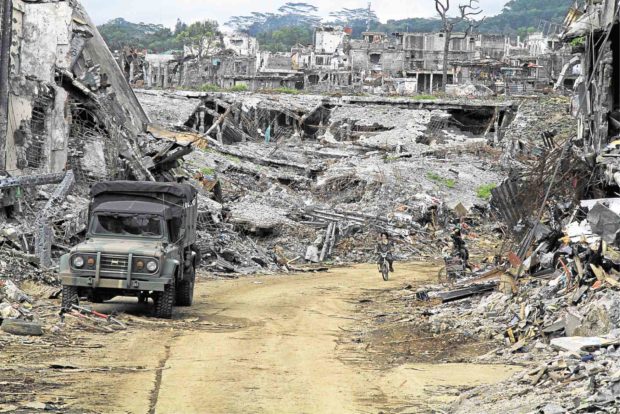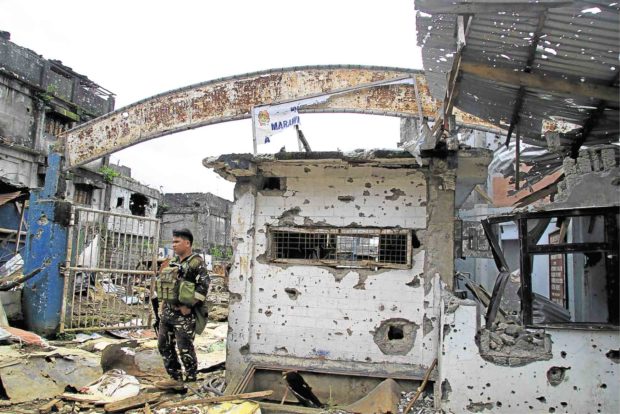Padian: Site of terrorists’ last stand, my favorite haunt is no more

HEAVY DAMAGE What was once the commercial district of Padian in the aftermath of five months of Marawi siege —RICHEL V. UMEL
PADIAN, MARAWI CITY—The smell of decaying flesh was unmistakable as we entered Padian—the city’s commercial district ravaged by the gunbattles that ensued after Islamic State (IS)-inspired militants went on a rampage on May 23.
The acrid fumes from smouldering debris and gunpowder, which filled the air, and the breeze blowing from Lake Lanao could not overpower the stench.
No human or animal remains were visible from where I stood. I suspected that the smell of death came from underneath the rubble.
As I looked around, all I could see were ruins and I was hit by a pang of sorrow and loss.
I knew prewar Padian because I was a frequent visitor and I was familiar with the hustle and bustle of the place.
Article continues after this advertisementDuring those days, one could barely inch forward, especially on Padian’s market day when it was so crowded and people packed the streets.
Article continues after this advertisementToday, no rush of crowds overwhelmed me, only the sight of utter destruction.
Gone were the images in my mind of Marawi’s commercial center.
The scene in front of me was straight out of Mosul in Iraq, which was also ravaged by war—buildings turned into heaps of smashed concrete and twisted steel bars, cracked walls pockmarked with bullet holes of every imaginable size and jagged pillars and beams—skeletons where once stood buildings and homes.
In the midst of the rubble lies the local mosque’s cream-colored and bullet-riddled minaret, which collapsed on its side, its dome looking like it had been badly peeled away using a giant grater. Some of the trees were leafless, burnt away by fires or sheared off by the shock waves from exploding bombs.
The row of my favorite eateries that served “bulalo” and all kinds of chicken dishes and the wooden buildings that housed them were gone—razed to the ground during the fighting. The military said pro-IS fighters set them ablaze so they could use the thick black smoke to cover their escape.

ISLAMIC CITY IN RUINS The provincial and city governments prepare Marawi for rehabilitation and reconstruction.
The one-story Padian commercial center building, which had a basement full of shops that sold Maranao brassware and other local products, is now a mound of debris.
The only icon that was largely unscathed was the “I Love Marawi” signage beside the lake, where locals and tourists had their pictures taken.
This is what remains of Padian and its neighborhood where many Maranaos had built their homes, raised their families and where some had made their fortunes.
The place looked so desolate one could not help but wonder what kind of future lies ahead for the people’s lives and livelihood.
I was emotional, too, because I could relate to their suffering. As a high school student in 1972, my family was forced to flee because fighting had broken out between Moro rebels and the Ilaga paramilitary group.
Only 14 years old at that time, my young eyes saw the horrors of the conflict—buildings in ruins and bodies of civilians and soldiers who were killed in ambuscades in Lanao’s hinterlands.
I thought I wouldn’t see it in Padian anymore.
Col. Samuel Yonque, the commanding officer of the Army’s 1st Scout Ranger Battalion, tried to explain the destruction in Marawi, particularly Padian where the IS-inspired fighters made their last stand.
It was in Padian where one of the fiercest battles during the tailend of the war took place and where military airstrikes and shellings were among the most intense because most of the buildings were fortified or well-built.
The terrorists were to be blamed, too, because it was their siege that eventually led to the destruction of Padian and its surroundings.
Earlier in the fighting, the military said the airstrikes were necessary to deny the enemies places to hide. These were also intended to expose the tunnels and the basements that the terrorists used to maneuver without being seen.
In the end, the militants were defeated, leaving Padian looking like it had been struck by a powerful earthquake. Only a few severely damaged buildings were left standing. Everything here crumbled like cookies in the hands of a toddler.
I held back my emotions as I looked around. From a distance, I saw a TV reporter, also trying to hold back tears. Who would not be heartbroken at the sight of all the devastation?
But as a photojournalist, I had to rein in my feelings and do my job, clicking away with my camera to record everything I possibly could for the world to see.
Indeed, war is ugly. I hope nothing like this happens again.
(Editor’s Note: Richel Umel covered the Marawi conflict since the start of the fighting.)